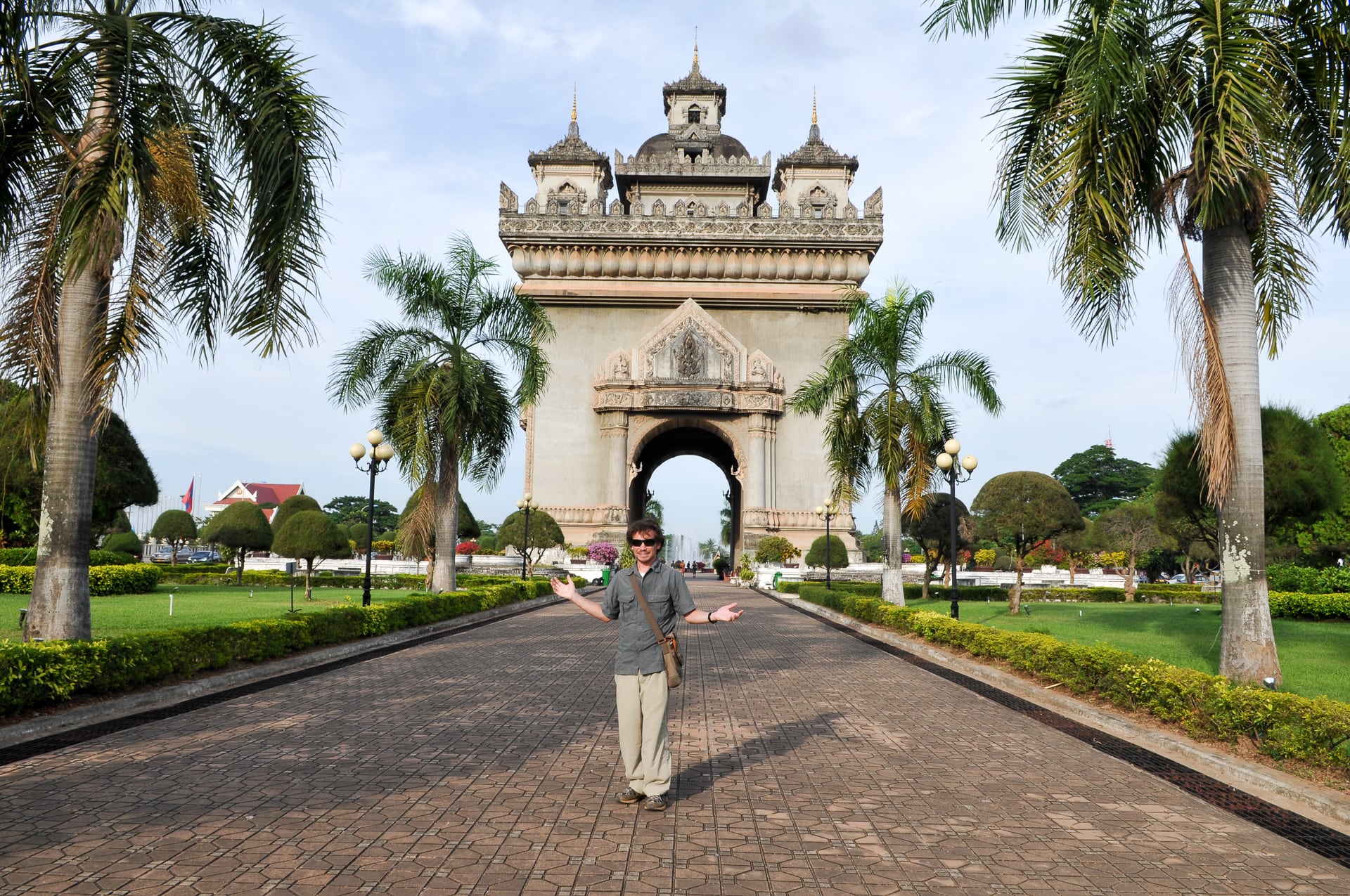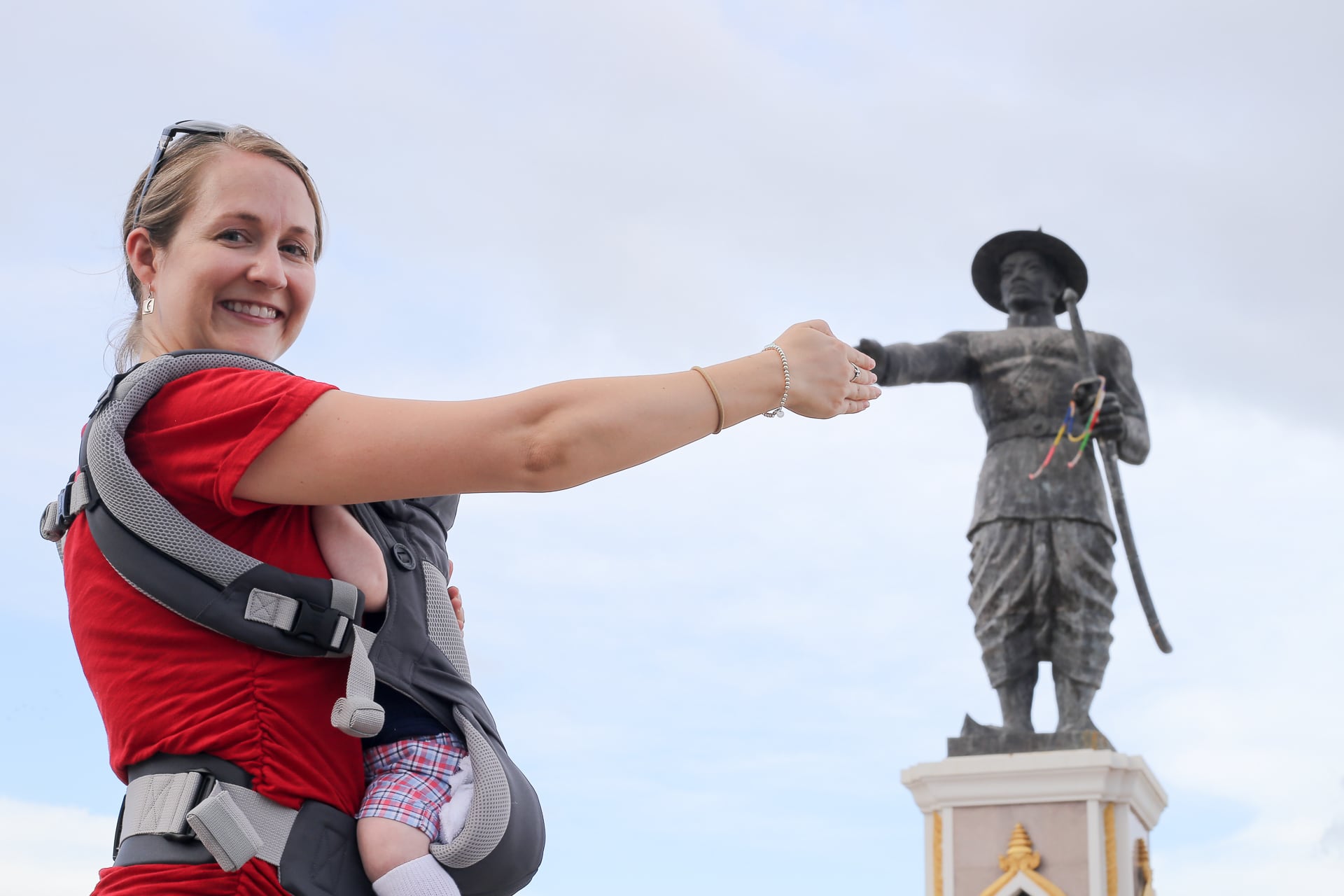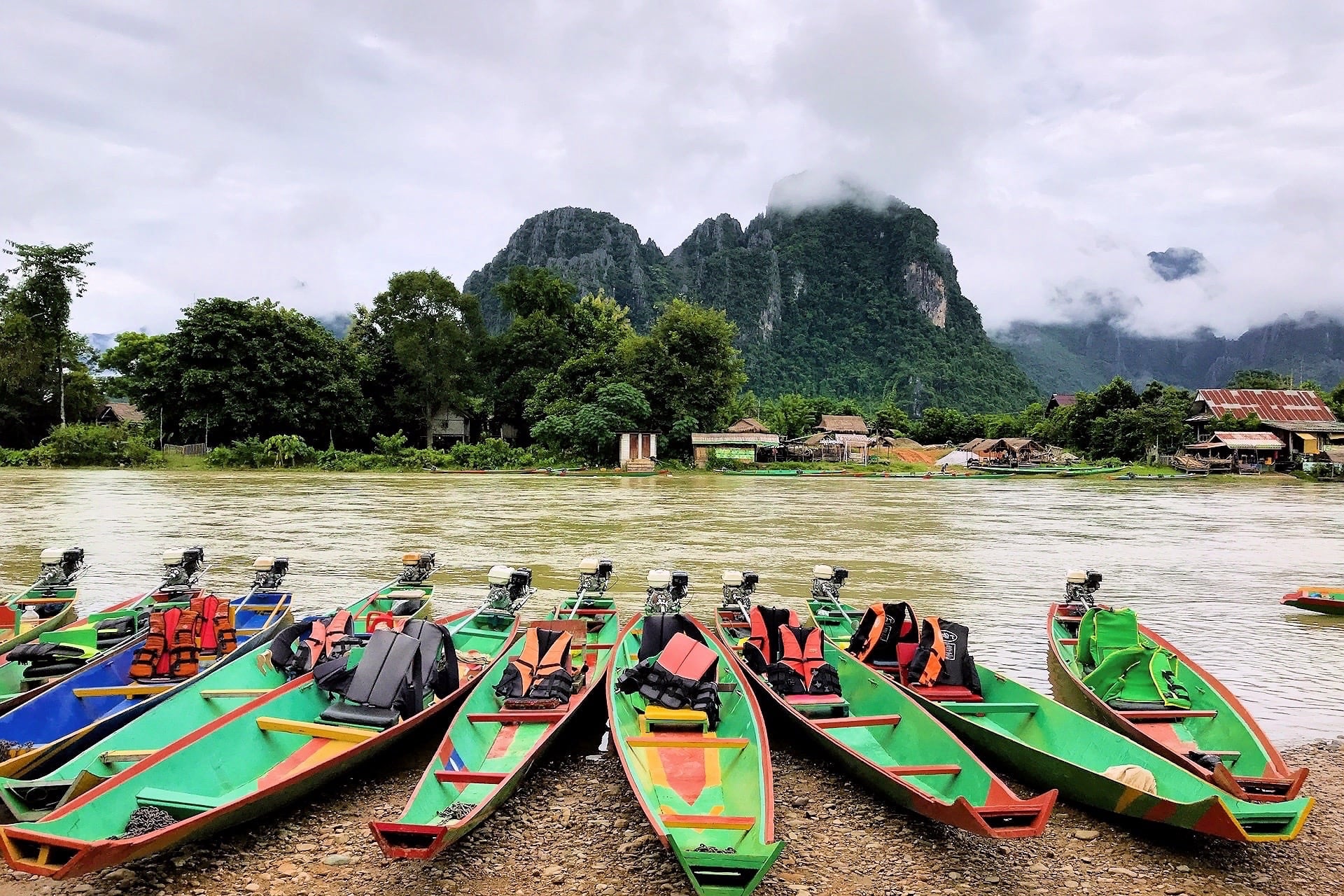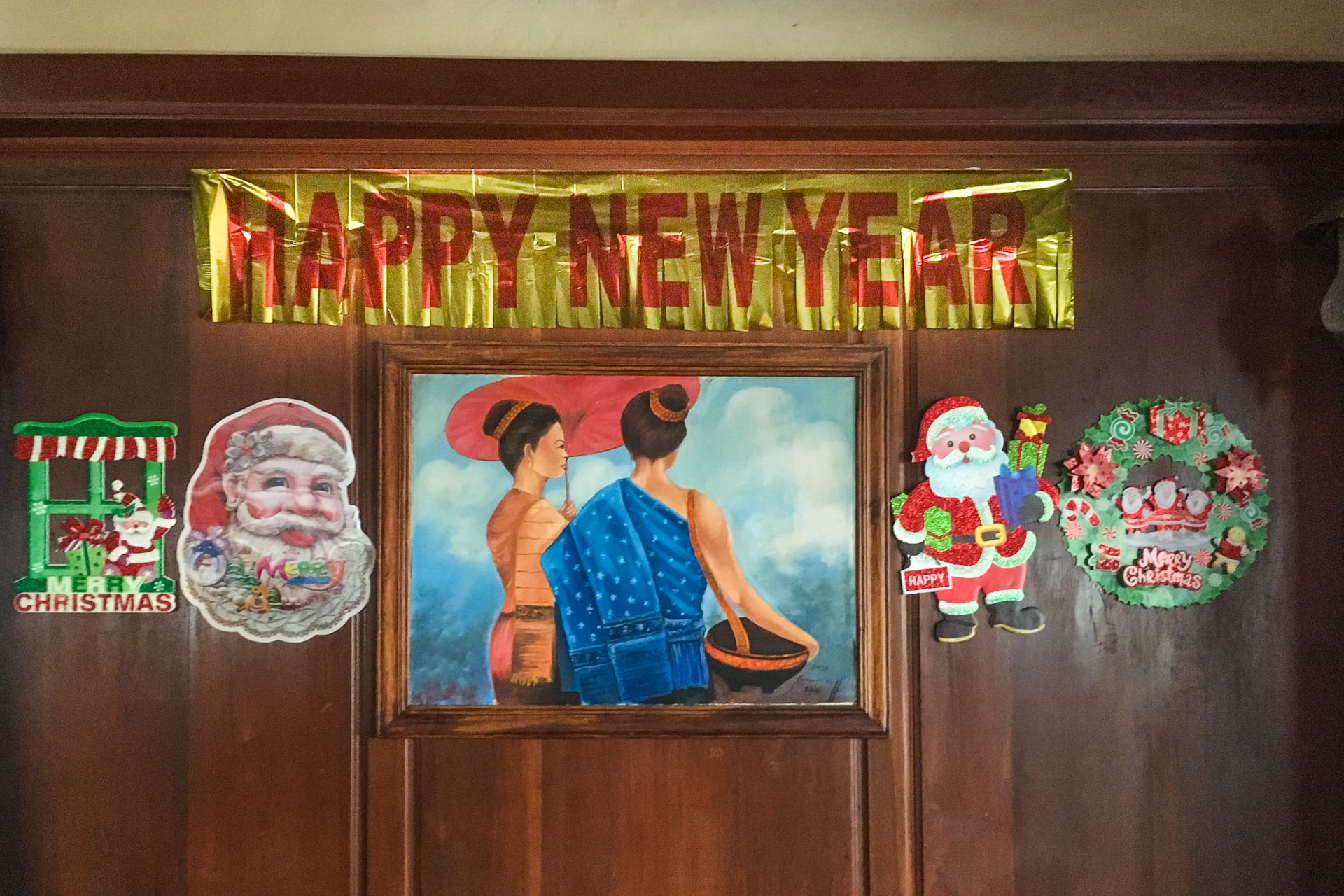
I realized after moving here that I posted quite a bit from our first three weeks in Laos in 2012: Mekong slow boat, Motorbiking the Thakhek loop, and hanging out on two of the 4,000 Islands of Si Phan Don. But I never got around to posting about our future home, in which we spent four of those days. A lot has changed in four years, but much more has remained the same, which isn’t necessarily a bad thing as far as Vientiane is concerned. Here’s a look back at our first stay in Vientiane (in October 2012.

One of the first things that struck us immediately about Laos in general was the food–first in Luang Prabang, then in Vientiane: Really delicious and varied offerings at a great value. We spent our first evening in the capital at renowned Amphone, having their famous Lao Sausage and fried spring rolls and washing it down with a BeerLao.

Our original home in Vientiane, Siri 1 guesthouse, a steal at US$10/night, if you didn’t mind the early morning construction clatter coming from the place next-door. It had a relatively homey common area and an upstairs common area that was one of the few quite places on the property to get internet (with the understanding that it may become a massive hotbox at any moment (in both, the traditional ganja sense, and literal sense in the event of a power cut). I know, sounds too good to be true, right? Well, before you go booking a week’s stay there, looks like you should check out some of the more recent online reviews…unfortunately it seems they’ve let the place go a bit. Shame.

And then there’s JOMA Bakery Cafe, a Western traveler’s morning oasis in Southeast Asia. Bagels! Need I say more? Started at this very location by two North American couples over a decade ago, JOMA has spread throughout Laos, Cambodia and Vietnam and is a model for fresh, local (and hard to get) ingredients, locally sourced organic, Fair Trade coffee, and providing job training and employment opportunities to victims of human rights abuses. Plus, their salmon lox bagel is the best ANYWHERE. Still, one of my favorite coffee shops on the planet.


Ah, the Mighty Mekong. Well, you’d hardly know it from the riverfront here. Don Chan [island] right in the heart of downtown makes it appear as if the lifeline of Southeast Asia has all but dried up, which is even more pronounced in the dry season.


Not many people out and about on a hot and steamy midweek afternoon.
And now, I present to you, the Vientiane of the future!

A repeating billboard on a nearby construction wall. You might recognize the building near the center with the red roof (it’s the hotel in the previous photo on the waterfront). Seems they might have just a bit of a ways to go…

Public trash cans made out of recycled tires!

Nice to make your acquaintance, King Chaoanouvong!


We saw these construction billboards all over the city — this one is for the shiny and modern World Trade Center, “The core of Vientiane colors your life.”

All of these billboards are quite varied in their depictions and marketing imagery but have one thing in common: they seem completely out of touch with reality…at least today’s reality. But I’m sure it’s just a matter of time until the Chinese arrive en masse and recreate Vientiane in their image. If I thought that change would be truly beneficial to the average Laotian, I may feel a bit less pessimistic. Hopefully this country will figure out a middle road that lifts up the poor and working class without denigrating and destroying the unique and genuine character of Laos and its capital city. Time will tell.
And now, Patuxay!

Patuxay (pa-TU-sai), literally meaning ‘Victory Gate’ in Lao, was constructed by the former monarchy between 1957 and 1968 in remembrance of the Laotian soldiers who died in WWII and those who fought in the struggle for independence from French colonial rule in the following years. The most interesting thing about the monument, however, may be that it was built using American funds and cement intended to build a new airport, which also earned it the nickname ‘the vertical runway’ among expats.
It may not be Bangkok’s Suvarnabhumi Airport, but the views from the top deck are arguably so much more fabulous.
Looking northwest, you’ve got the Government’s Palace.


And towards the northeast, there’s Patuxay Park and fountain.



Speaking of celebrating casting off the chains of former colonial masters, French food, anyone?

The French may be gone, but their food lives on. As strange as it feels, a meal at a French cafe or restaurant is sort of a thing to do when visiting Vientiane. Lao food really gives us no reason to look elsewhere for our daily sustenance, but we just couldn’t bring ourselves to pass up some highly recommended French cuisine in Southeast Asia (in addition to the fine baguette with Laughing Cow cheese that we had already sampled at the odd inter-city bus station). While French bistros do seem to be a dying breed in these here parts, Le Provencal, is a long-standing favorite and one of the last true holdouts.

Our last full day in Vientiane begins with a walk through one of the city’s most famous and revered places: Wat Si Saket.
Built in 1818, Si Saket is a Siamese style temple and houses over 2,000 images of Buddha. It is believed to be the oldest original Buddhist temple still standing in Vientiane.


This temple has a particular significance for Lori and me as it was in this very place, after four months on the road from Shanghai, through China, then India, Thailand and now Laos, that I took a look around at all the grey headed Misters and Madames and had a revelation. I was tired of leisurely walks through temples and other heritage sites that could be seen comfortably at nearly any age or with any age of children. It was time to do something challenging and a little scary — something that required endurance and independence.
Lori: Do you have something in mind?
Me: Not really…well, there is this one thing I’ve heard of, but you’re definitely going to say no.
Lori: Try me.
Me: What would you say about heading deep into some of the most remote areas of Laos for four days, staying at local guesthouses, and exploring a 4.5-mile subterranean river on the way?
Lori: And why would I say no to that?
Me: Because it involves covering over 100 miles on the back of a motorbike…?


It’s a minor miracle that she agreed to it, but the next morning we were bound for Thakhek, the staging town for riding the Thakhek Loop. And with that, we left Vientiane behind…for now.





I’m getting excited about our trip by reading this post!